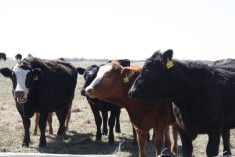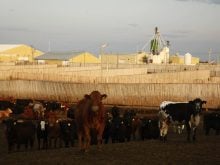This cattle market information is selected from the weekly report from Canfax, a division of the Canadian Cattlemen’s Association. More market information, analysis and statistics are available by becoming a Canfax subscriber by calling 403-275-5110 or at www.canfax.ca.
Fed prices steady
Western Canadian fed prices have been steady for the past seven weeks. Ontario and U.S. prices continue to advance. December is traditionally a strong month for the fed cattle market. However, enthusiasm has been muted by smaller fed slaughter volumes during the second half of this year and historically long pick-up times.
Read Also

VIDEO: Ag in Motion documentary launches second season
The second season of the the Western Producer’s documentary series about Ag in Motion launched Oct. 8.
On a cash basis, Alberta fed prices are trading at a $28 per hundredweight discount against the Nebraska market and $7.76 per cwt. discount to the Ontario market.
Last week, dressed bids and sales were reported from $304-$305 per cwt. delivered. Cattle were scheduled for mid-January delivery. Last year pick up times in late November-early December were three to four weeks out. This year packers are bought out at seven weeks.
Light volumes of Alberta fed cattle traded to the United States at US$235 per cwt. delivered, depending on freight, and dressing percentage sales were working back to the mid $180s per cwt. at a premium over local deals.
Year to date, Canadian heifer slaughter volumes are five percent larger than last year. Over the past 15 years this is the second largest heifer slaughter. The only year larger was 2010.
Ontario dressed sales were reported from $315-$320 per cwt., steady to $5 per cwt. higher than the previous week. Cattle were being booked for one to two week delivery.
In the U.S., dressed sales in Iowa and Nebraska ranged from US$245-$249 per cwt., steady to a couple dollars stronger than the previous week. Live sales in Nebraska were at $157 per cwt. and sales in southern regions were at $155, fully steady.
Packers have been running full or maximum hours during the week, but limited hours on Saturday. There has been some thought that Saturday shifts could be eliminated as processing margins narrow.
U.S. beef cow slaughter has averaged more than 80,000 head for the past six weeks. For the week ending Nov. 19, beef cow slaughter totalled slightly more than 82,000 head. For the second half of November, this is the largest slaughter since 2011.
Cow price slips
Ample slaughter cow marketings were reported at auction last week, and prices eased lower. D2 cow prices slipped $3.40 per cwt. lower than the previous week to average $83.20 per cwt. and were at a $13+ per cwt. discount to Ontario and U.S. utility cows last week. Alberta D3s averaged $73.70.
Dressed cow bids slipped $5 per cwt. lower than the previous week to around $160-$165 per cwt. delivered. Western Canadian non-fed slaughter for the week ending Nov. 26 was down four percent from the previous week, and for the second week in a row was above 9,000 head. Butcher bull prices averaged $118.64 per cwt.
A seasonally ample bred offering last week was disappointing, with cows averaging $1,730 per head and bred heifers at $1,971 per head. Buyer interest was mixed.
Cold affects feeders
Alberta feeder prices eased modestly lower last week as frigid temperatures across the Prairies limited marketing and buyer interest. Calves from 400-700 pounds traded mixed, with steer prices steady to $2.50 per cwt. lower, and heifer prices trended steady to $1.35 per cwt. higher. Large feeders more than 700 lb. traded seasonally softer on reduced lot size and quality.
Saskatchewan calf prices were comparable with Alberta last week, but Manitoba calves, in close proximity to the Ontario market, commanded a premium.
Alberta auction volumes were 33 percent lower than the previous week and were 16 percent smaller than a year ago. Year to date, auction volumes are down three percent from the same week last year, totalling 1,578,955 head, but were four percent larger than the five-year average. Canadian feeder exports to the U.S. for the week ending Nov. 19 were 49 percent larger than the previous week at 3,208 head and were 40 percent lower than the same week last year. Year to date, feeder exports were 54 percent larger than year ago, totalling 185,800 head.
Cut-out spread widens
In U.S. beef trade, Choice cut-outs traded steady and closed last week at US$253.57 per cwt. Select cutouts are seasonally softening and fell 3.6 percent to $225 per cwt. The Choice/Select spread widened last week compared to historical trends.
















